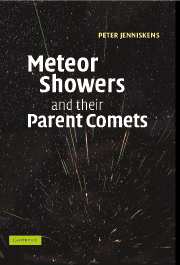Book contents
- Frontmatter
- Dedication
- Contents
- Preface
- Acknowledgements
- Part I Introduction
- 1 How meteor showers were linked to comets
- 2 What is at the core of comets?
- 3 The formation of meteoroid streams
- 4 Meteors from meteoroid impacts on Earth
- 5 Comet and meteoroid orbits
- Part II Parent bodies
- Part III Young streams from water vapor drag
- Part IV Young streams from comet fragmentation
- Part V Old streams and sporadic meteoroids
- Part VI Impact and relevance of meteor showers
- Appendix
- Tables
- Index
- Units and constants
3 - The formation of meteoroid streams
from Part I - Introduction
Published online by Cambridge University Press: 05 July 2015
- Frontmatter
- Dedication
- Contents
- Preface
- Acknowledgements
- Part I Introduction
- 1 How meteor showers were linked to comets
- 2 What is at the core of comets?
- 3 The formation of meteoroid streams
- 4 Meteors from meteoroid impacts on Earth
- 5 Comet and meteoroid orbits
- Part II Parent bodies
- Part III Young streams from water vapor drag
- Part IV Young streams from comet fragmentation
- Part V Old streams and sporadic meteoroids
- Part VI Impact and relevance of meteor showers
- Appendix
- Tables
- Index
- Units and constants
Summary
Meteoroid streams in space used to be invisible, their existence illuminated only by the meteor showers they caused on Earth. Then, in 1983, dust trails were discovered in the orbit of short-period comets. Dust grains absorb visible light, warm up, and re-emit that energy as thermal emission in the mid-infrared.
My Alma Mater at Leiden Observatory was deeply involved in the interpretation of data from the monumental 1983 all-sky survey of heat emissions at the mid-infrared wavelengths of 12, 25, 60, and 100 μm by the InfraRed Astronomical Satellite (IRAS), a joint project of the USA, UK, and the Netherlands. The observatory had a vested interest in the topic of interstellar dust, with my professor, Harm Habing, being one of the leading investigators of IRAS. As in so many astronomical institutes, meteor studies were delegated to amateurs. I was such an amateur, joining the ranks of the Dutch Meteor Society two years earlier.
When the news spread that the images from IRAS showed dust trails in the path of comets, I immediately suspected a link with meteor outbursts. It was the excellent 1986 report by Mark Sykes and coworkers, with details of the width of the trails and estimates of the sizes of the dust grain, that first alerted me to the trails, although the discovery was made by John Davies a few years earlier and published in a paper that discussed other things as well.
John Davies, a scientist involved with the IRAS moving object project at the University of Hawai'i, recalls how he discovered the trails in the images of the IRAS satellite: “One day in August, 1983 the fast moving object detection software seemed to find a number of ‘asteroids’ all in the same patch of sky. None of these looked right and they could not have been a single object being detected several times as the motion would have been too erratic to be real, so I did not worry too much about them.”
[…]
- Type
- Chapter
- Information
- Meteor Showers and their Parent Comets , pp. 28 - 38Publisher: Cambridge University PressPrint publication year: 2006



